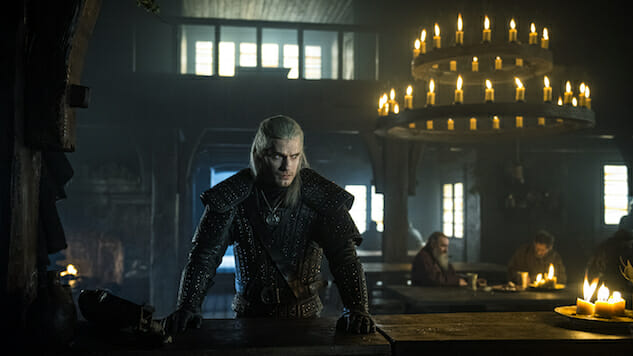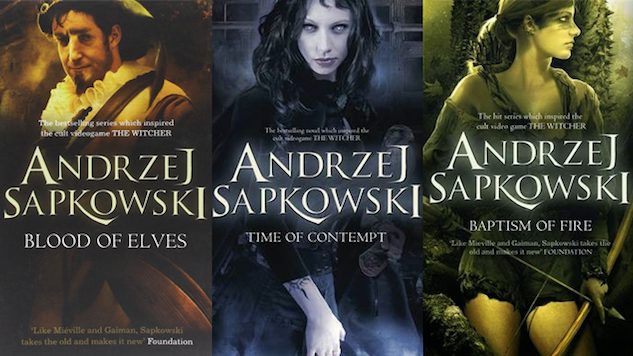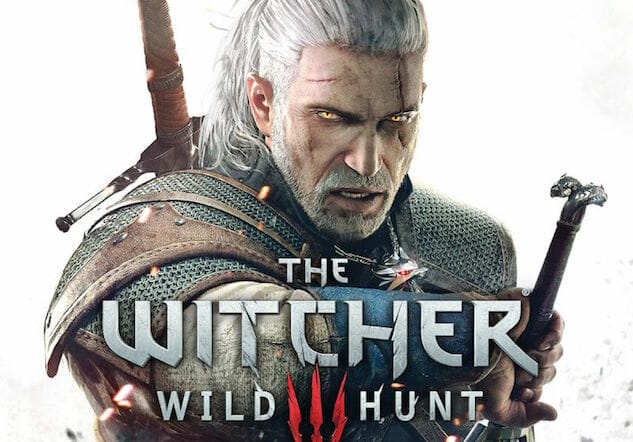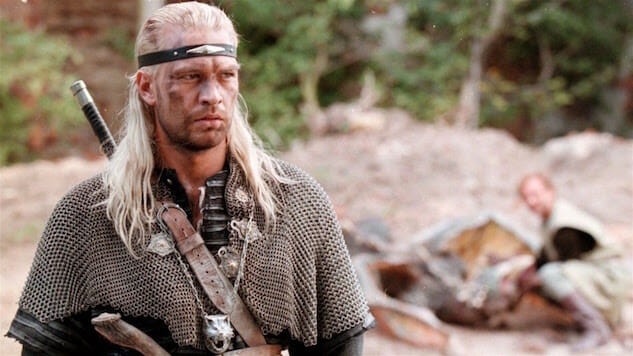A Witcher Watcher’s Guide to The Witcher Universe: Books, Games, and More
Photo Courtesy of Netflix Books Features The Witcher
So you’ve finished watching Netflix’s The Witcher, but your thirst to see Geralt and company in action is still not fulfilled—what are you to do? Yes, you could watch the show for the fourth time, or you could dive into the greater Witcher world! Don’t worry, I’m here to be your guide. There is a lot of Witcher content between a whole book series and the widely popular videogame RPG series of the same name. Sadly, nothing else Witcher-related features Henry Cavill in tight leather trousers, but few things are as objectively perfect as that. Now you’re probably wondering, where should I start? Well, a safe place to start would be the books! It is where The Witcher began, after all.
A Studying Witcher: The Books

The stories of Geralt of Rivia first started in Poland in the mid-1980s. Witcher creator, Andrzej Sapkowski, published his first Witcher short story, Wied?min (“The Witcher”), in 1986 in the Polish fantasy magazine “Fantastyka.” From then on, varying amounts of The Witcher short stories were published in various formats—most now being out of print. Sapkowski went on to publish two short story collections, a saga of novels, and one standalone book in The Witcher universe, and most were released to critical and commercial success in Poland/eastern Europe.
As for where to begin after one has finished Netflix’s adaptation, Sapkowski’s short story collection, “The Last Wish,” is the best place to start. It introduces readers to Geralt and the world of The Witcher without holding their hands. It trusts readers enough to throw us into this grimy fantasy world, and it pays off in spades. A few of the short stories in “The Last Wish” serve as core story beats in The Witcher TV show; though I will not say which. Read the short story collection and find out! You will not regret it.
From there, the Witcher saga of novels is where I’d go next. The core novels should be read in this order: “Blood of Elves,” “Time of Contempt,” “Baptism of Fire,” “The Tower of the Swallow,” “The Lady of the Lake,” and finally “A Season of Storms.” Yes, there is another short story collection, “Sword of Destiny”, but it is best read after the core series. It serves as a nice epilogue to Geralt’s saga and reminds readers where it all began—with one man, a certain set of skills, and a world full of monsters. All of The Witcher books are, more or less, great fantasy reads and show us new and interesting sides of Geralt, Dandelion (who Jaskier is based on), Yennefer, Triss, and the rest of the ever-interesting core cast. While they can sometimes get muddled in politicking, the series always finds its way again. Sapkowski’s works deserve to be read by more western audiences, and the show is a brilliant primer to his written world.
Now that you’ve read the core books, what’s next? More books! Well, comic books. Dark House published a surprisingly good series of Witcher comic books that were released around the time of the third Witcher videogame. But in December 2019, an omnibus edition of The Witcher comics was released, and that is where hungry readers should venture next. Penned by multi-Eisner award winning writer Paul Tobin, The Witcher comics follow the Geralt of the videogames as he goes on various adventures. The stories are short, simple, and the art is beautifully drawn by various comic artists (Dave Johnson, Dan Panosian, Stan Sakai, Duncan Fegredo, and Simon Bisley). Better yet, the eye-catching cover art was done by Hellboy’s own Mike Mignola. While not paradigm shifting, The Witcher comics are exactly what they should be: more Witcher stories that explore the interesting world and themes of the novels/games.
Lastly, for those whose affinity for the written Witcher word cannot be satiated, CD Projekt Red—the developer of The Witcher videogames—released, with help from Dark Horse Comics, a book titled “The World of The Witcher.” It is a big, thick lore bible that has anything a travelling Witcher (or Witcher aficionado) would need: maps, a monster compendium, character biographies, and more. It belongs on the coffee table of every fan of The Witcher—that is if their coffee table is big enough. A shelf, too, will suffice.
A Practicing Witcher: The Games

Ah, yes. We’ve arrived. Odds are that if you’re familiar with The Witcher, it is through CD Projekt Red’s award-winning RPG series that has been around since 2007. From humble beginnings as a janky eastern European PC RPG to a bonafide smash hit with The Witcher 3: Wild Hunt, the videogames are endlessly compelling. But where should one start? That answer is pretty obvious. Start with The Witcher 3: Wild Hunt, as it is the best and most welcoming of The Witcher videogames, and it is on every modern console. It even has a Nintendo Switch port that is shockingly playable! Playing as an older, wry, and handsomely bearded Geralt is an utter joy, and exploring the world of The Witcher 3: Wild Hunt is an exercise in always being able to find compelling human stories within a low fantasy setting. Yes, wars and plagues are afoot. Yes, werewolves are vivisecting farmers. Yes, there is this supernatural force called The Wild Hunt that Geralt is not so fond of. But the world is chock-full of interesting human narratives that color every shade of the human experience—from the ugliest and meanest tales to the most jovial, lowkey ones. The Witcher 3: Wild Hunt is an endlessly recommendable game that has only gotten better with two stellar DLC expansions, Hearts of Stone (a brilliant little heist gone awry), and Blood and Wine (a gigantic expansion that sees Geralt in a world reminiscent to middle ages Italy that is full of twisted versions of Grimm’s Fairy Tales and vampires). If you’re on the fence about it, just play The Witcher 3: Wild Hunt—brilliant characters, gameplay, and stories await you, fellow Witcher.
Still want more, huh? Well, there are CD Projekt Red’s two previous titles in The Witcher series, The Witcher (2007) and The Witcher 2: Assassin of Kings (2011). Both are great games in their own right, but The Witcher 2: Assassin of Kings is the most playable (and easily accessible) of the two. It is on PC, Xbox 360, and on Xbox One via backwards compatibility—meaning that your Xbox One can read and play a copy of the game’s Xbox 360 disc. I found a copy about a year ago for a few bucks at my local Half Price Books, and it is worth seeking out and playing! The story of the second game is more linear than the third and, in some ways, far more riveting. It is also replayable due to the fact that there is one big second act choice that decides how and where the next fifteen-or-so hours will play out. Play The Witcher 2: Assassin of Kings!
As for The Witcher, it is exclusively on PC and far harder to play, not due to it being hard to find, but due to just how janky and weird it is. To those of us who played it around the time it came out, we can often see such idiosyncrasies as nostalgic colorings of character. But in reality, it is just obtuse and unwelcoming for new players. So, unless you’re a diehard fan you’re better off just reading a summary of the game’s core narrative or watching a playthrough. Though, as an unabashed fan of that first game, if you have a PC and a desire to give it a shot, then come to the game as it is, be patient, and maybe it’ll click with you. It really is brimming with personality beyond the awful gameplay.
There are still more games in The Witcher universe! Gwent is a free-to-play competitive digital card game a la Hearthstone that was first introduced in The Witcher 3: Wild Hunt. Gwent spun off into its own thing and is now an online game with relatively large (and competitive) online community. Gwent is fun but it is very much its own thing. Its ties to The WItcher universe are small, but it is a fun title nonetheless—especially if you are already a fan of competitive card games.
Next, there is Thronebreaker: The Witcher Tales. CD Projekt Red released this spin-off title for consoles and PC in 2018, and the game plays like a mix between Gwent and The Witcher 3: Wild Hunt. All of the combat encounters resemble the card-based encounters of Gwent while the rest of the game is played like a classic top-down RPG. Players control Queen Meve in a narrative that precedes the first Witcher game and the 30-or-so hour narrative sees the player having to make key narrative choices, fight in various battles, and take on all kinds of side missions. It is an interesting videogame that tells a great story, but one’s enjoyment of the title will vary depending on how much they enjoy card-based combat.
Back into the real world we go—Fantasy Flight released an adventure board game based on The Witcher in 2014. The Witcher Adventure Game is pretty simple to play as players travel across a board and complete quests. Players are tasked with becoming the greatest hero on the continent by taking on quests, developing their skills, and more. It is a fun time with a few friends and the simplistic nature of the experience means that you can play it with almost anyone. Yes, you can make your family play it during family holidays and get togethers! Grandma might have the makings of a great witcher. Then there is Taslorian Games’ The Witcher Tabletop Roleplaying Game. Like Dungeons & Dragons and other tabletop roleplaying games, The Witcher Tabletop Roleplaying Game sees adventures and a DM (dungeon master i.e. key storyteller) embarking on campaigns within the world of The Witcher. Dice rolls and stat checks abound!
A Bewildered Witcher: The Polish TV Show

Wiedzmin (The Witcher) aired on Polish television in 2002 and it is absolutely bonkers. Yes, the budget was low and maybe 2002 was not the time to adapt such a dense, effects-needy book series. While the Polish TV show is absolutely weird and objectively poorly made, it has so much heart. If you do not want to wait until 2021 for the second season of Netflix’s The Witcher, then maybe open a bottle of wine (or three) and binge the Polish television show. If anything, it’ll make for an unforgettable experience.
A Witcher’s Journey Fulfilled
And there you have it, my fellow Witchers, witches, wizards, and bards. This guide on all things The Witcher should (hopefully) fulfill hungry fans until 2021. So, toss a coin to any of these various The Witcher entities and get lost in that fantasy world you love, all over again.
Cole Henry is a freelancer writer and an avid taco enthusiast. You can follow him on Twitter @colehenry19
For all the latest TV news, reviews, lists and features, follow @Paste_TV.